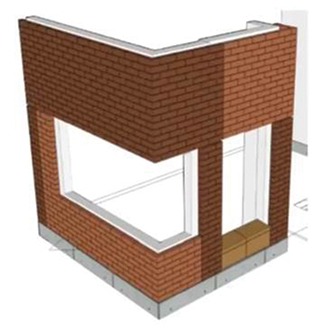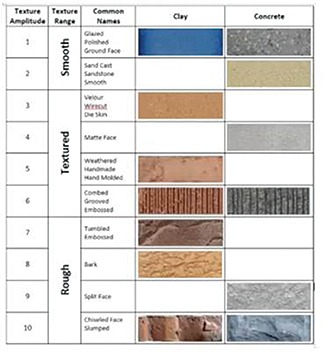BIM for Masonry: The Progress Continues
Words: David BiggsJanuary 2015
Software
By David Biggs, P.E., S.E.
Opening graphic courtesy of Tradesmen’s Software Inc .
Since 2012, the masonry industry has been advancing Building Information Modeling (BIM) for masonry. This initiative (BIM-M) is intended to expand the use of masonry within the construction industry by promoting the development of tools that will help architects, engineers, manufacturers, masons, contractors and owners. The growth of BIM feels like it’s expanding exponentially, so the need for these tools is expanding faster than their development.
At a recent Executive Committee meeting for BIM-M, reports of on-going projects and several new approved ones were received. Each project is listed on the BIM-M website, www.bimformasonry.org, and new data is added as it becomes available.
On-going BIM-M projects
On-going BIM-M projects
Project 1 – Masonry Unit Model Definition
This project targets development of a standardized format or database for representing masonry units in BIM models. Under the leadership of Jeff Elder, SE from Interstate Brick and Western States Clay Products Association, manufacturers of CMU, clay brick and cast stone have identified the attributes of their materials that are regularly requested by users during the design and construction of projects.
That data was reported to BIM-M consultant Georgia Institute of Technology’s (Georgia Tech) Digital Building Laboratory led by Russell Gentry and Chuck Eastman. The compiled data has assembled into a BIM schema that is reported (see http://bimformasonry.org/pdf/phase-ii-masonry-unit-model-definition-project-report-from-georgia-tech-august-13-2014.pdf and a video at www.youtube.com/watch?v=qi7sQ0Y0Sf8 is also available).
Next steps: Georgia Tech is now soliciting the participation of software vendors to prepare demonstration databases for CMU and clay brick. A goal is that one or more vendors will be available to host their products online in a format that BIM users can have ready access to information for modeling and decision making.
The Executive Committee also took steps to integrate the development of cast stone, natural stone and manufactured stone products within the proposed data structure. Close behind is an effort to bring masonry accessories into the overall BIM database structure.
Project 2 – BIM-M benchmark
This Georgia Tech project has assistance from the University of Pennsylvania (Penn). The primary goals are to a) document construction phase workflows, b) identify the use of BIM tools during construction, and c) improve efficiencies throughout the construction project. While the emphasis is on the use of BIM for new masonry construction, restoration work ultimately will be included in BIM-M.
Next steps: The BIM-M Contractor Input Working Group (CIWG) of mason contractors and others will be validating the workflows developed by Georgia Tech and Penn before the workflows move on to development of new BIM tools.
Project 3 – Masonry wall model definition
This project is led by Jamie Davis, PE from Ryan Biggs/Clark Davis, and is moving along quickly. It goals are to a) identify wall types and systems for use in BIM models and b) prepare Level of Development (LOD) criteria for acceptance and integration into the BIMForum standards. The volunteer side of the project consists of the The Masonry Society (TMS) BIM Committee with Georgia Tech as a consultant.
The project work is documented on the BIM-M website. Very recent advances include the presentation of LOD recommendations. The masonry industry is being proactive in preparing this information, rather than awaiting others to tell us what is important. The LOD adoption will lead to both uniformity of data presentation as well flexibility for masonry designers. A goal will be to encourage the use of masonry BIM models from the design through construction phases and on into the life of the building for maintenance.
 |
 |
A major new effort within this project is production of a “Best Practices Guide” for masonry modeling in Revit. Revit is the BIM authoring software most used by designers and contractors in North America. Following an open Request for Proposals, two firms were selected to develop masonry BIM models, identify challenges in representing BIM Masonry models, prepare “work arounds” for those challenges, and assist in the production of a masonry guide to help current Revit users. It benefits all users, not just designers. Autodesk is supporting this effort and will aid in the guide development. TMS’s BIM Committee will prepare and release the guide.
Next steps: Preliminary results of the “Best Practices Guide” will be available in April 2015, with the guide release targeted for the fall of 2015. It will free to masonry BIM users.
Project 4 – Contractor input and education
This project is led by Darrell McMillian, PE of the Masonry Institute of St Louis and TMS. Its goal is to identify mason contractor challenges throughout a project and determine whether BIM technology can be used to address those challenges. Members are being solicited from mason contractors and others interested in achieving greater efficiencies in the construction of masonry.ÂÂÂ The working group has its own website, http://ciwg.weebly.com. Using surveys and personal contact, members provide input to BIM-M on topics such as material selection and delivery, layout, scaffolding, site safety, planning, scheduling and more.
Next step: Mason contractor data collection is ongoing. CIWG members will review the Project 2-Benchmark results. All of this leads to BIM-M projects to integrate mason contractor needs into BIM software. The development of BIM-related tools for mason contractors (software, apps, mobile devices, hands-free headsets, robotics and more) will be considered.
The Education portion of this project is progressing with the assistance of a consultant, Art Theusch of Collaborative Consulting Group (art.theusch@collaborativecg.com).
Collaborative has prepared a BIM-M course titled “Mobile Devices for Construction.”
There are two goals for this course:
- To identify mobile devices and “apps” that will help masons and contractors be more efficient with their daily work and business right now.
- To get masons accustomed with mobile devices in the workplace. As BIM tools for masonry develop, masons will be more comfortable in making the transition to BIM.
The mobile device course addresses mobile devices, apps and cloud computing. BIM-M will be offering the course as seminars, webinars and free downloads. Visit the BIM-M website for the latest information. Masonry groups and organizations can schedule a live presentation by contacting Collaborative Consulting group directly.
Another BIM-M offering is the “Introduction to Computers” course. This is intended to provide elementary knowledge on computer use for those who may not have access to local training.
Next steps:ÂÂÂ BIM-M will be posting more webinars on its website and announcing seminar dates and locations. Courses are available as free downloads. Mason contractors are urged to take the AGC BIM course at www.agc.org/cm-bim for a greater knowledge of BIM in general and its benefits.
What’s to come
BIM-M is pleased to announce the BIM-M 2015 Symposium on April 9-10, 2015. The symposium will bring together BIM users, BIM-M committee members, software vendors, material suppliers, mason contractors, construction managers and others to demonstrate current masonry BIM technology, uses and provide forecasts of future developments. Set your calendars now to attend, and see the future of our industry. More information will be available at www.bimformasonry.org in the coming months.
David T. Biggs, P.E., S.E., is a principal of Biggs Consulting Engineering in Saratoga Springs, N.Y. An international consultant, he specializes in structural forensic engineering, masonry design, historic restoration and the development of new masonry products. He is a Distinguished Member of ASCE and an Honorary Member of The Masonry Society, and currently serves as coordinator for the Building Information Modeling for Masonry Initiative for the United States and Canada.
Return to Table of Contents